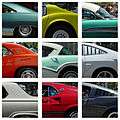Pillar (car)



Pillars are the vertical or near vertical supports of a car's window area or greenhouse—designated respectively as the A, B, C or (in larger cars) D-pillar, moving from the front to rear, in profile view.
The consistent alphabetical designation of a car's pillars provides a common reference for design discussion and critical communication. As an example, rescue teams employ pillar nomenclature to facilitate communication when cutting wrecked vehicles, as when using the jaws of life.[1]
The B pillars are sometimes referred to as "posts" (two-door or four-door post sedan).[2][3][4]
Design
In the case of the B (or center) pillar on four-door sedans, the pillar is typically a closed steel structure welded at the bottom to the car's rocker panel and floorpan, as well as on the top to the roof rail or panel.[5] This pillar provides structural support the vehicle's roof panel, as well as designed for latching the front door and mounting the hinges for the rear doors.[5]
As the most costly body components to develop or re-tool, a vehicle's roof and door design are a major factor in meeting safety and crash standards.[6] Some designs employ slimmer, chamfered windscreen pillars, A pillars, to help improve driver vision (thus reducing blind spots) through the use of stronger alloy steel in these components.[6] As "perhaps the most complex of all the structures on the vehicle", the center or B-pillar may be a multi-layered assembly of various lengths and strengths.[7]
Closed vehicles without a B-pillar are widely called hardtops and have been available in two or four-door body styles, in sedans, coupes and wagons.[8] Designs without a center or "B" pillar for roof support behind the front doors offer increased occupant visibility, while in turn requiring underbody strengthening to maintain structural rigidity.[9] In the early 1970s, General Motors broadened their definition of "hardtop" to include models with a B-pillar although: "up to then, everybody thought a hardtop was a car without a center pillar."[10]
Pillars are implied, whether they exist or not; where a design's greenhouse features a break between windows or doors without vertical support at that position, the non-existent pillar is "skipped" when naming the other pillars. Thus a two-door hardtop or a three box designed coupé could have its rearmost pillar called the C-pillar even in the absence of a B-pillar. Conversely additional doors, such as on limousines, will create additional B-pillars; the B-pillars are then numbered, B1, B2, and so forth.
In addition to the pillar nomenclature derived from viewing an automobile in profile, some older cars have a two-part windshield or a split rear window, with the two halves separated by a pillar. Posts for quarter windows (a smaller window typically between the front window and the windshield) are not considered a named pillar.
 A photographic typology illustrating variations of the design of the C-pillar
A photographic typology illustrating variations of the design of the C-pillar The B or center pillar between the front and rear doors on an AMC Concord station wagon
The B or center pillar between the front and rear doors on an AMC Concord station wagon- From left to right: C, B2, B1, and A-pillars, with small quarter glass in both doors (AMC Ambassador)
 A stretch limo with five pillars (Lincoln Town Car)
A stretch limo with five pillars (Lincoln Town Car)- An accident due in part to an A-pillar blind-spot
See also
- Automobile design
- Automotive head-up display
- Blind spot (automobile)
- Driver visibility
- Quarter glass
References
- ↑ Anderson, Brian G. (2005). Vehicle extrication: a practical guide. PennWell. pp. 141–143. Retrieved 12 September 2014.
- ↑ Mueller, Mike (2015). Chevy Chevelle Fifty Years. Motorbooks. p. 26. ISBN 9780760346532. Retrieved 22 May 2016.
Postwar American sedans, with two doors or four, can be recognized by the B-pillar, or “post,” located between front and rear side glass.
- ↑ Bedwell, Steve (2009). Holden Vs Ford: The Cars, the Culture, the Competition. Rockpool. p. 313. ISBN 9781459619906. Retrieved 22 May 2016.
- ↑ Bongard, Tim; Coulter, Bill (2001). The cars of the king: Richard Petty. Sports Publications. p. 14. ISBN 9781582613178. Retrieved 22 May 2016.
The two Pettys alternated between a 1959 Plaza two-door post sedan and a Savoy two- door hardtop.
- 1 2 Scharff, Robert; Mullen, Keith; Corinchock, John A. (1990). Complete automotive estimating. Delmar Publishers. p. 172. ISBN 9780827335851. Retrieved 12 September 2014.
- 1 2 Kenwright, Joe (4 November 2007). "Slimmer Commodore windscreen pillars coming". Carpoint Australia. Retrieved 12 September 2014.
- ↑ Thomas, Alfred; Jund, Michael (2013). Collision Repair and Refinishing: A Foundation Course for Technicians (Second ed.). Cengage Learning. pp. 479–480. ISBN 9781285687032. Retrieved 12 September 2014.
- ↑ "Rambler has everything new - even a hardtop wagon". Popular Mechanics. 105 (1): 116–117. January 1956. Retrieved 12 September 2014.
- ↑ Thomas, Alfred; Jund, Michael (2009). Collision repair and refinishing: a foundation course for technicians. Cengage Learning. p. 164. ISBN 978-1-4018-8994-4. Retrieved 12 September 2014.
- ↑ Lund, Robert (June 1974). "Detroit Listening Post — same cars, different label". Popular Mechanics. 141 (6): 42. Retrieved 12 September 2014.
External links
- "Art of Automotive C Pillars"—flickr photo group created 2005-07-26; webpage accessed 2008-02-10